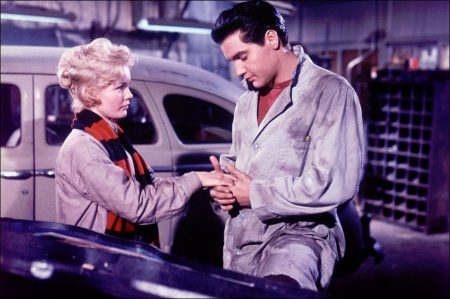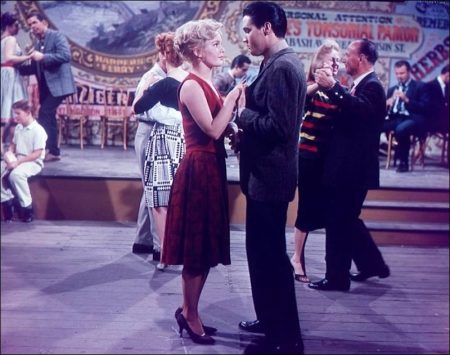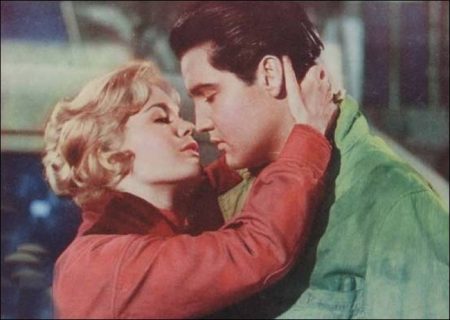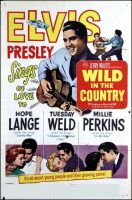Wild in the Country movie storyline. Glenn Tyler (Elvis Presley) gets into a fight with and badly injures his drunken brother. A court releases him on probation into the care of his uncle in a small town, appointing Irene Sperry (Hope Lange) to give him psychological counselling. Marked as a trouble-maker, he is falsely suspected of various misdemeanors including an affair with Irene. Eventually shown to be innocent, he leaves to go to college and become a writer.
Wild in the Country is a 1961 American musical–drama film directed by Philip Dunne and starring Elvis Presley, Hope Lange, Tuesday Weld, and Millie Perkins. Based on the 1958 novel The Lost Country by J. R. Salamanca, the screenplay concerns a troubled young man from a dysfunctional family who pursues a literary career. The screenplay was written by playwright Clifford Odets.
About the Shooting and Soundtrack
Wild in the Country started filming in November 1960. It was the last movie to shoot at the colonial mansion which had been on the studio backlot since 1934 – this was knocked down and sold after filming completed.
The movie was also shot on location in Napa Valley and in Hollywood Studios, although it is set in the Shenandoah Valley. The cast and crew created a public sensation in Napa for over two months of filming. The motel where many of the cast stayed, Casa Beliveau (since torn down), was so mobbed that Elvis had to be moved to the St. Helena home that was being used in the film as Irene Sperry’s house, where Glenn Tyler went for counseling. Now a top-rated inn in Napa Valley and known as The Ink House, the room where Presley stayed for over two months can still be rented.
Other Napa Valley locations featured in the movie. The opening scene was filmed along portions of the Napa River. This section of the river is located at what is now the Casa Nuestra Winery, between Calistoga and St. Helena. Calistoga’s downtown main street was used as the hometown of Glenn Tyler’s uncle and his cousin. Other filming locations in Napa Valley include the Silverado Trail between Calistoga and St. Helena, the Cameo Cinema (then The Roxy), an old movie theater still in operation in downtown St. Helena where the dance hall scenes with Elvis and Tuesday Weld were filmed, and the hills and farmland behind what is now Whitehall Lane Winery just north of the town of Rutherford.
Dunne recalled, “For his love scenes with Hope Lange, he couldn’t get the right tempo so, I had him listen to Bach’s Fifth Brandenburg Concerto. Presley listened intently, then said, ‘Hey, man, now I get it!’ And he did the smooching very slowly, in one take.”
The Ink House was used as the house and backyard where a drunken Glenn Tyler tries to hose down Irene Sperry through the porch window, and the nearby 1885 barn is where Irene Sperry drives her DeSoto in to attempt suicide when she is so distraught over her suspected romance with Glenn and the scandal it has caused. In one scene, Betty Lee slaps Glenn. Millie Perkins suffered a broken arm while doing the scene, and before the film was released, the scene ended up being cut out of the movie.
Philip Dunne says that 20th Century Fox insisted on the insertion of four songs for Elvis Presley. This was Elvis’ last dramatic lead role until Charro! as his next film, Blue Hawaii, was his first big budget musical and was a box office sensation. All his subsequent movies were largely formula musicals which were quite lucrative but never gave him the chance to develop his potential as a serious actor that was very apparent in Wild in the Country.
Presley began an off-screen romance with Hollywood “bad girl” Tuesday Weld but the relationship was short-lived after Elvis’s manager, Colonel Tom Parker, warned him against his involvement, fearful it would harm his image. Elvis and Hope Lange also were quite taken with each other, but her separation from her husband did not result in a divorce until the next summer making her unavailable for a serious relationship.
Other notable members in the cast included Jason Robards, Sr. (in his final role), Christina Crawford (daughter of Joan Crawford), Pat Buttram and the legendary Rudd Weatherwax who trained the animals used in the movie. Recording sessions took place on November 7 and 8, 1960, at Radio Recorders in Hollywood, California, under the supervision of producer Urban Thielmann. Five songs were recorded for the film, with “Lonely Man” and “Forget Me Never” left out of the film.
Since Wild in the Country showcased Presley the actor rather than the singing star, RCA elected to release neither a long-playing album nor an EP as the soundtrack for a Presley film. The Colonel promised 20th Century Fox to assist with promotion by releasing some songs on singles. :143 Despite being cut from the film, “Lonely Man” was actually the first song from the score to be released, appearing on February 7, 1961 as catalogue 47-7850b, the B-side of Presley’s chart-topping hit single, “Surrender.”
The title track to the film, “Wild in the Country”, was released on the very next single, catalogue 47-7880b on May 2, 1961, as the B-side of the No.5 hit “I Feel So Bad.” Both B-sides made the Billboard Hot 100 independently of their A-sides, “Lonely Man” peaking at No.32 and “Wild in the Country” at No.26.
The songs “In My Way” and “Forget Me Never” would be included on the 1965 anniversary compilation album Elvis for Everyone, while “I Slipped, I Stumbled, I Fell” appeared on the 1961 album Something for Everybody. The soundtrack was re-released on the Follow that Dream collectors label with unreleased outtakes of all the songs.
Wild in the Country (1961)
Directed by: Philip Dunne
Starring: Elvis Presley, Hope Lange, Tuesday Weld, Millie Perkins, Rafer Johnson, John Ireland, Gary Lockwood, William Mims, Raymond Greenleaf, Christina Crawford, Pat Buttram, Jason Robards
Screenplay by: Clifford Odets
Production Design by: Edward Woehler
Cinematography by: William C. Mellor
Film Editing by: Dorothy Spencer
Costume Design by: Donfeld
Set Decoration by: Stuart A. Reiss, Walter M. Scott
Art Direction by: E. Preston Ames, Jack Martin Smith
Makeup Department: Ben Nye, Helen Turpin
Music by: Kenyon Hopkins
MPAA Rating: None.
Distributed by: 20th Century Fox
Release Date: June 9, 1961 (New York City)
Views: 373



